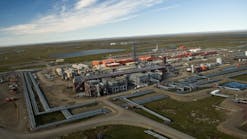P. 4 ~ Continued - Dependent on dependence: Are economic calculations of expected hydrocarbon accumulations worthwhile?
View Article as Single page
Economic considerations
In deciding whether to undertake a project a corporation usually makes an assessment first of likely reserves and then undertakes an economic valuation based on costs of drilling, chances of success, selling price of product, and so on. A corporation will usually run through a series of scenarios changing the conditions of probabilities, reserves anticipated, etc.
But now with the above simple two-reservoir calculation, one has the situation where one has precisely the same expected value and precisely the same standard deviation around the expected value no matter how one changes the probability—within the dependency limits given. Thus there is no way a corporation can now know what probability to assign to reservoir B to assess a change in economic worth.
This ambiguity means that there is no clear-cut decision available to a corporation. It also means that groups within a corporation can promote high probabilities of success with low resource potential whereas equally valid are low probabilities of success with high resource potential—based on either positive or negative dependence.
There is no other measure available because the expected value and standard deviation are the same for all such situations, a true quandary for a corporation considering the worth of undertaking a project.
As also pointed out, it does not help to change the dependence condition (i.e., to change the condition to a fixed value other than Pb) because all one does by so doing is to change the allowed range of probabilities without changing the essential fact that the EV and standard deviation are again fixed, independent of the value chosen.
Even more disconcerting is that the example given is a simple decision tree determination. For more complex decision trees (usually the rule in corporate decision making) there is always some sort of dependence of one outcome on others. What is unknown is how one can sort out the situations where variables do change as one adjusts parameters from those situations where only partial variation occurs because of lack of dependence; to date there would not seem to be available any general method for so doing. This problem is an outstanding concern.
Discussion and conclusion
Perhaps the central issue here is that if the expected value and variance do not chance with dependency such means that dependency in a portfolio is also not important in the long run.
If one drills 20 wells all dependent then they will all succeed or fail and have an EV of $100 million or, if independent, some will succeed and others fail but the EV is still $100 million. The only difference might be how quickly the two situations regress to that mean value of $100 million/year average. Since the expected volatility is the same, both situations will regress at the same rate (after 20 years one will make the same profit in the long run).
However, what the simple model discussed here shows is that corporations that really want to include dependence will spend more money trying to resolve situations that are intrinsically irresolvable and cannot be distinguished from independent cases—a somewhat less than satisfactory situation.
The problem is to find a general procedure that will allow one to identify such dependent situations and when they might be worthwhile to pursue relative to treating the exploration assessment from a completely independent viewpoint. This problem is an open domain at the time of writing.
The real economic issue here is the lack of ability to get value from information. The situation considered is where one takes it that a corporation always drills both prospects regardless of the outcome of A. As such the expected value does not change, but if the company could decide to stop because of the known dependence then the expected value will change. So if one is going to drill both reservoirs regardless, do not estimate dependence. If one might stop after drilling prospect A then it is important to know this fact.
Apart from the unanticipated behavior uncovered here with dependence, there are two further aspects to the basic problem. First is the question of the financial expected value, uncertainty, and cumulative probability of making a profit under a situation where dependence is present; second is the problem of correlation between reservoir amounts, so that if one reservoir has a high (low) reserve estimate then the second reservoir can have either a high (low) reserve estimate if the reservoirs are considered positively correlated or can have a low (high) reserve estimate if the reservoirs are negatively correlated. These two aspects have not been addressed here because interest was focused on showing the dependence behavior with as clean and simple an illustration as possible. These deferred problems will be addressed elsewhere.
Displaying 4/5
View Article as Single page

